Metal Gear Rising - cutting
The author of the translation asks readers to apologize for the strange expressions, the confusion of the story and other oddities. The style of the author is maximally preserved, and the article is a translation of the article “Metal Gear Rising - Slicing” .

In Metal Gear Rising, you can cut objects into very small pieces. Of course, something like this has already been implemented earlier, for example in Tiny and Big, Afro Samurai or Crysis. But Rising impressed me the most. Real cut, unlimited. Here's a techno demo:
')
I didn’t have any idea how to do this at all. I searched on polycount and found that this thing seems to be called “realtime cgs”. But I'm not 100% sure about this, but what am I doing in such situations? I ask people. Trees in Crysis can be swept through, I asked Marcel 'me about it. He shared an interesting link about how the Boolean speaker works in CryEngine . Then I installed my old version of Crysis and looked at it myself:

This surprised me because usually when Boolean logic is applied in 3Ds Max or Maya, the result is a single object. Even if you make a hole, a hole, in the end it’s still one object. But here there is a new object, independent and having its own body. Cool! And this very object is also used to break broken surfaces:
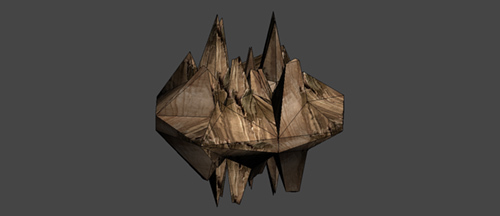
Another thing mentioned by Surfa was the wound drawing technique in L4D2, which is also very impressive. They “simply” do not draw the pixels inside the invisible sphere and fill the hole formed with an appetizing looking warped flesh model.

But as for me, this is clearly not the technology that was used in Rising. In any case, check out this video, where AirAardvark repeated the injury system from L4D2:

Marginal note: In Germany, we do not see these wounds, because in our country there is a strict censorship of violence. On the other hand, we have no problems with sex and nipples: D
We are lucky! Since Platinum Games (they made MGR) don't just make great games, they also run a cool development blog (where you can download any hosted video in HD, cute!). There I found a lot of interesting information about their approach to cutting.
They can define several different internal surfaces " for each part of the body ." I do not know whether it means “for the bone” or how else they ask these very parts. But the picture in the blog should explain what it means:
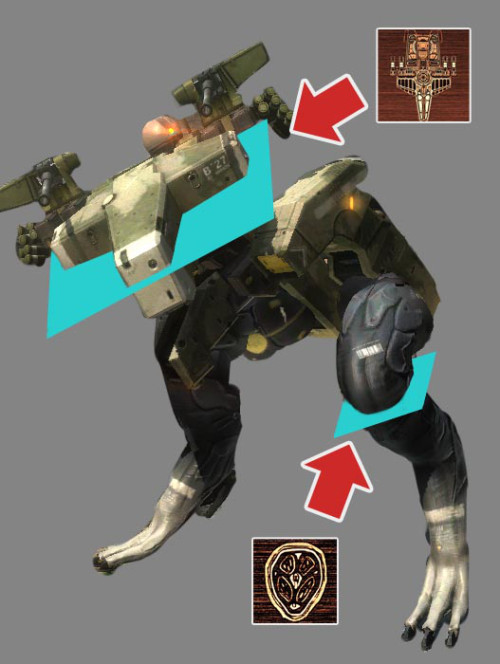
They can at least specify which texture will be used for horizontal, and which for vertical cuts: " horizontal cuts give an orange section, and vertical sections - watermelon .". This is pretty cool, especially when it comes to cutting off the members of the android body.
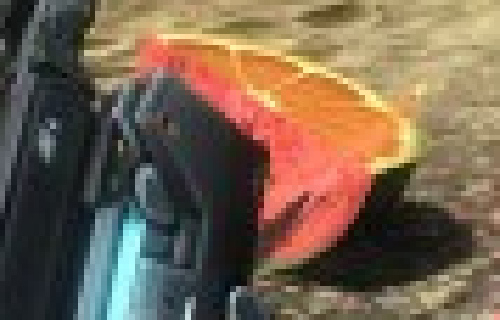
When you cut off the body parts of the enemy, they must react to it. I would say that the solution dynamics would be the best to do without creating a huge number of animations. But Rising was not satisfied with the procedural nonsense and did everything in its own way:
“We cut the enemy from one side and add animation, cut from another angle and add another animation, repeating this process until the end of development. Until we were finally satisfied with the array of reactions that we can get from each enemy ”( source ).
Here are three basic facts that I was able to gather from their blog. However, I found more interesting while studying the game. But keep in mind: I do not know for sure, only I believe that this is so.
They can share the structure of the skeleton of the characters when they are hit / dead. Similar special enemies show us that this is possible at any time. But in this case with pre-defined cutting points. I think this is just awesome!

It seems that they did something like a depth to cut. Two things allowed me to come to this thought. The first is that the internal cut of the melon looks very low poly (the green line in the picture - Approx. Lane). After some reflection on this, I am almost certain that this is not procedural depth, perhaps they have two levels of geometry: the watermelon rind (with a green texture) and, of course, the inside.

The second - a cut near the edge of the watermelon does not give a scarlet pulp of watermelon:

Well, well, you can use a spherical (obviously meant polar - Approx. Lane) texture with a rim for watermelon, but then the thickness of the rim will be different depending on how large the piece is cut. And more importantly, it will not work on square watermelons:

There is nothing unusual here, but perhaps it is worth mentioning: the objects are not obliged to be "whole". They can be hollow and cut only their whole part.

Not any living object can be cut. And I think it's great. Nobody wants to see how this cat will be crippled!

In most 3D RPG games, the weapon is “hanging in the air” when the character wears it on its back. Easy enough and cheap. And I was surprised that in MGR there will be something in this particular part. Of course, there is not a huge amount of armor and various weapons, but I really like what they did. Maybe this will inspire modern RPGs to avoid making weapons hanging in the air, by adding a small “hand” to the weapon.
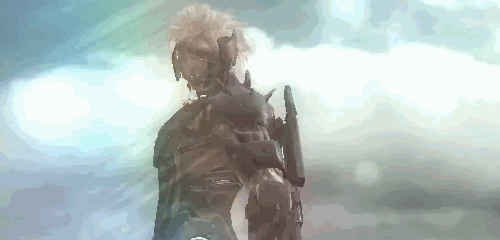
I also observed some “problems” or, let's say, limitations. I would like to emphasize that I like what we have achieved in MGR! It's incredibly cool and what I write about it should be taken as my interest in this, but not an accusation!
Before I took control of the game, I asked myself what if every object would be destroyed. Of course, this is not an option. And I think that is so much better for level design and performance. But why, for example, some cars are destructible, while others are not. This is what I do not understand.

Suppose we have a roof that stands on 4 pillars, in this case some games have a balance problem. They do not check it. Therefore, it is easy to demolish three of the four columns and the roof will stand until you destroy the last column. For me, it is obvious that MGR solved this problem in an “interesting” way:
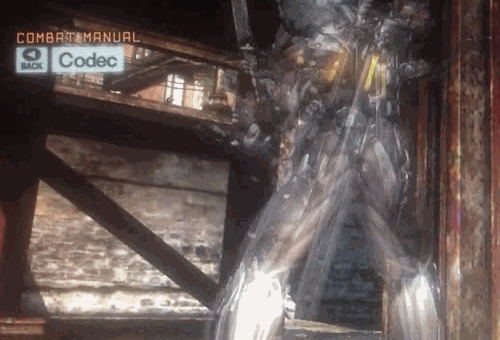
Usually after cutting we get only two objects. But sometimes, in special cases, it turns out more than one object generated after the slice, and without any physical connection. Nevertheless, the logic of the game treats them as one:
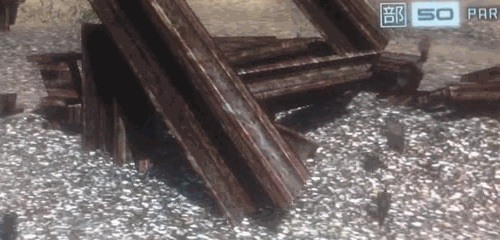
Before purchasing the game, I asked myself the question, how did they solve the problem, when after some time thousands of objects would roll around the whole level. Answer: after cutting, after 10 seconds the objects dissolve:

Defining an internal texture has its problems when it is applied to more detailed objects, such as a couch. You will be very surprised when you sit on this, because the pillows are made entirely of wool.

When there are a lot of chopped objects around and it seems that the engine is no longer cutting the new parts, until the number of objects decreases (dissolve). I'm not 100% sure that this is the case, but the feeling is that in terms of performance, this makes sense.
Some of the links that do not affect the perception of information, I allowed myself to move to the end of the article:

In Metal Gear Rising, you can cut objects into very small pieces. Of course, something like this has already been implemented earlier, for example in Tiny and Big, Afro Samurai or Crysis. But Rising impressed me the most. Real cut, unlimited. Here's a techno demo:
')
Crysis
I didn’t have any idea how to do this at all. I searched on polycount and found that this thing seems to be called “realtime cgs”. But I'm not 100% sure about this, but what am I doing in such situations? I ask people. Trees in Crysis can be swept through, I asked Marcel 'me about it. He shared an interesting link about how the Boolean speaker works in CryEngine . Then I installed my old version of Crysis and looked at it myself:

This surprised me because usually when Boolean logic is applied in 3Ds Max or Maya, the result is a single object. Even if you make a hole, a hole, in the end it’s still one object. But here there is a new object, independent and having its own body. Cool! And this very object is also used to break broken surfaces:

L4D2
Another thing mentioned by Surfa was the wound drawing technique in L4D2, which is also very impressive. They “simply” do not draw the pixels inside the invisible sphere and fill the hole formed with an appetizing looking warped flesh model.

But as for me, this is clearly not the technology that was used in Rising. In any case, check out this video, where AirAardvark repeated the injury system from L4D2:

Marginal note: In Germany, we do not see these wounds, because in our country there is a strict censorship of violence. On the other hand, we have no problems with sex and nipples: D
Metal Gear Rising
We are lucky! Since Platinum Games (they made MGR) don't just make great games, they also run a cool development blog (where you can download any hosted video in HD, cute!). There I found a lot of interesting information about their approach to cutting.
Fact №1 "Cut Position"
They can define several different internal surfaces " for each part of the body ." I do not know whether it means “for the bone” or how else they ask these very parts. But the picture in the blog should explain what it means:

Fact number 2 "Direction cut"
They can at least specify which texture will be used for horizontal, and which for vertical cuts: " horizontal cuts give an orange section, and vertical sections - watermelon .". This is pretty cool, especially when it comes to cutting off the members of the android body.

Fact number 3 "Reaction cutoff"
When you cut off the body parts of the enemy, they must react to it. I would say that the solution dynamics would be the best to do without creating a huge number of animations. But Rising was not satisfied with the procedural nonsense and did everything in its own way:
“We cut the enemy from one side and add animation, cut from another angle and add another animation, repeating this process until the end of development. Until we were finally satisfied with the array of reactions that we can get from each enemy ”( source ).
Here are three basic facts that I was able to gather from their blog. However, I found more interesting while studying the game. But keep in mind: I do not know for sure, only I believe that this is so.
Observation number 1 "Dynamic Skeleton"
They can share the structure of the skeleton of the characters when they are hit / dead. Similar special enemies show us that this is possible at any time. But in this case with pre-defined cutting points. I think this is just awesome!

Observation number 2 "Cut Depth"
It seems that they did something like a depth to cut. Two things allowed me to come to this thought. The first is that the internal cut of the melon looks very low poly (the green line in the picture - Approx. Lane). After some reflection on this, I am almost certain that this is not procedural depth, perhaps they have two levels of geometry: the watermelon rind (with a green texture) and, of course, the inside.

The second - a cut near the edge of the watermelon does not give a scarlet pulp of watermelon:

Well, well, you can use a spherical (obviously meant polar - Approx. Lane) texture with a rim for watermelon, but then the thickness of the rim will be different depending on how large the piece is cut. And more importantly, it will not work on square watermelons:

Observation number 3 "Hollow objects"
There is nothing unusual here, but perhaps it is worth mentioning: the objects are not obliged to be "whole". They can be hollow and cut only their whole part.

Observation number 4 "Cut only cyborgs!"
Not any living object can be cut. And I think it's great. Nobody wants to see how this cat will be crippled!

Observation number 5 "Third Hand"
In most 3D RPG games, the weapon is “hanging in the air” when the character wears it on its back. Easy enough and cheap. And I was surprised that in MGR there will be something in this particular part. Of course, there is not a huge amount of armor and various weapons, but I really like what they did. Maybe this will inspire modern RPGs to avoid making weapons hanging in the air, by adding a small “hand” to the weapon.

I also observed some “problems” or, let's say, limitations. I would like to emphasize that I like what we have achieved in MGR! It's incredibly cool and what I write about it should be taken as my interest in this, but not an accusation!
Restriction №1 "Indestructible objects"
Before I took control of the game, I asked myself what if every object would be destroyed. Of course, this is not an option. And I think that is so much better for level design and performance. But why, for example, some cars are destructible, while others are not. This is what I do not understand.

Limit number 2 "The problem of balance"
Suppose we have a roof that stands on 4 pillars, in this case some games have a balance problem. They do not check it. Therefore, it is easy to demolish three of the four columns and the roof will stand until you destroy the last column. For me, it is obvious that MGR solved this problem in an “interesting” way:

Limit number 3 "There is no multiplicity of objects"
Usually after cutting we get only two objects. But sometimes, in special cases, it turns out more than one object generated after the slice, and without any physical connection. Nevertheless, the logic of the game treats them as one:

Restriction №4 "Fat extinction"
Before purchasing the game, I asked myself the question, how did they solve the problem, when after some time thousands of objects would roll around the whole level. Answer: after cutting, after 10 seconds the objects dissolve:

Restriction №5 "Internal texture"
Defining an internal texture has its problems when it is applied to more detailed objects, such as a couch. You will be very surprised when you sit on this, because the pillows are made entirely of wool.

Limit number 6 "Number of slices"
When there are a lot of chopped objects around and it seems that the engine is no longer cutting the new parts, until the number of objects decreases (dissolve). I'm not 100% sure that this is the case, but the feeling is that in terms of performance, this makes sense.
Some of the links that do not affect the perception of information, I allowed myself to move to the end of the article:
Source: https://habr.com/ru/post/256771/
All Articles